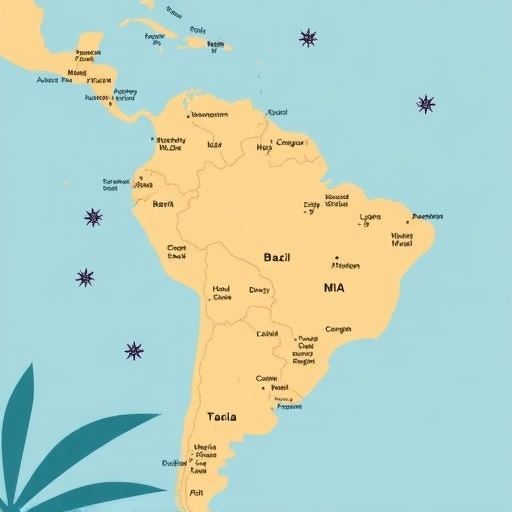In recent years, the global health community has been persistently challenged by the emergence and re-emergence of arboviruses, particularly those transmitted by Aedes aegypti mosquitoes. Among these, chikungunya, dengue, and Zika viruses have repeatedly sparked widespread outbreaks across tropical and subtropical regions. While the acute clinical manifestations of these infections are well-documented, the ramifications of maternal infection during pregnancy remain an area of intense scientific scrutiny. A new landmark registry-based cohort study conducted in Brazil, spearheaded by Cerqueira-Silva and colleagues, sheds crucial light on the perinatal outcomes associated with symptomatic infection by chikungunya, dengue, and Zika viruses in pregnant individuals.
The study leverages the extensive epidemiological surveillance systems in Brazil, encompassing regions with high incidence of arboviral diseases. This comprehensive dataset enabled researchers to analyze thousands of cases where pregnant individuals presented symptoms consistent with these infections, correlating viral exposure during gestation with detailed neonatal health parameters. Given that Brazil has historically faced simultaneous or sequential epidemics of these viruses, the research context is particularly apt for disentangling their distinct impacts on maternal and fetal health outcomes.
Pathophysiologically, chikungunya, dengue, and Zika viruses, while all arthropod-borne flaviviruses or alphaviruses, differ fundamentally in their mechanisms of host invasion, immune evasion, and tissue tropism. Dengue virus is notorious for inducing vascular leakage and hemorrhagic complications, often mediated by a complex interplay of viral serotypes and host antibody-dependent enhancement. In contrast, chikungunya virus predominantly targets musculoskeletal tissues but has also been implicated in neurological complications. Zika virus stands apart due to its neurotropic tendencies, especially its capacity to cross the placental barrier, leading to devastating congenital brain anomalies collectively termed congenital Zika syndrome.
.adsslot_JCfoOhZDkR{width:728px !important;height:90px !important;}
@media(max-width:1199px){ .adsslot_JCfoOhZDkR{width:468px !important;height:60px !important;}
}
@media(max-width:767px){ .adsslot_JCfoOhZDkR{width:320px !important;height:50px !important;}
}
ADVERTISEMENT
Brazil’s robust perinatal registries allowed the researchers to statistically account for confounding variables such as maternal age, trimester of infection, socioeconomic status, and access to healthcare services. This rigor enhanced the validity of associations drawn between symptomatic maternal infection and a spectrum of adverse perinatal outcomes, ranging from preterm birth, low birth weight, to fetal demise. Notably, the study addresses symptomatic infections exclusively, which is a critical criterion since many arboviral infections remain subclinical and could yield different risk profiles.
One of the pivotal findings underscored by Cerqueira-Silva et al. relates to the differential impact of the viruses on pregnancy outcomes. Zika virus infections during pregnancy were significantly associated with a marked increase in rates of preterm labor and severe neurologic sequelae in neonates. This aligns with prior experimental and clinical data but is especially meaningful given the population-level confirmation within a real-world registry. The temporal aspect of infection was also crucial; first and second trimester exposures were linked with more severe outcomes compared to third trimester infections, highlighting windows of heightened vulnerability during embryogenesis and fetal neurodevelopment.
Conversely, symptomatic dengue infection in pregnant individuals correlated with increased risk of hemorrhagic complications and maternal morbidity, which indirectly affected fetal health. The vascular pathogenesis of dengue likely contributes to placental insufficiency, which may predispose to intrauterine growth retardation and stillbirth. Chikungunya virus, though less studied in this context prior to this research, exhibited a distinct profile. Symptomatic chikungunya infection was associated with elevated inflammatory markers in maternal serum and an increased incidence of neonatal arthralgia and encephalitis, suggesting vertical transmission or postnatal exposure with early manifestations.
The study’s use of a comparative approach between these three arboviruses is a significant strength that elucidates not only shared but virus-specific risks in pregnancy. Such granularity in understanding is immensely valuable for public health practitioners when devising targeted surveillance and intervention strategies. Brazil’s multidisciplinary integration of obstetric, infectious disease, and public health data exemplifies best practices in applied epidemiology and translational research.
Beyond clinical correlations, the investigators employed advanced statistical modeling, including multivariate logistic regression and survival analyses, to control for coexisting morbidities such as hypertension, diabetes, and malnutrition. These confounders are pertinent given their known independent impact on pregnancy outcomes. The rigor in data cleaning and verification underscores the robustness of findings and strengthens causal inferences.
From a virological perspective, the study also encourages further exploration into viral kinetics during pregnancy. Although the registry lacked detailed viral load measurements, the symptomatic status serves as a proxy for viremia magnitude. Future investigations could expand on these findings by integrating molecular diagnostics and immunological profiling to dissect pathogen-host interactions at the maternal-fetal interface, particularly delineating how placental barrier integrity and immune tolerance modulate infection consequences.
The public health implications of this work are profound. Brazil, and by extension other endemic countries, face an urgent need to enhance prenatal screening and early detection protocols for arboviral infections. The nuanced distinctions in perinatal outcomes by virus type and infection timing underscore the importance of tailored counseling for affected pregnant individuals and the development of specialized neonatal monitoring programs to mitigate long-term disabilities.
Furthermore, this study reaffirms the critical necessity of vector control measures and vaccine development for these arboviruses. While dengue vaccines have made significant strides, chikungunya and Zika vaccines are still in various stages of development. Comprehensive vaccination campaigns targeted at women of childbearing age could dramatically reduce the incidence of these infections during pregnancy, subsequently decreasing adverse birth outcomes and the healthcare burden.
Importantly, the study also highlights gaps in knowledge, particularly concerning the mechanisms underlying viral placental transfer and host immunological response modulation. Insights from such research could open avenues for therapeutic interventions, including antivirals or immunomodulatory agents safe for use in pregnancy, which currently remain unavailable. The interplay between maternal immunity, viral virulence factors, and placental histopathology remains an exciting frontier.
In summary, the rigorous epidemiological analysis by Cerqueira-Silva et al. significantly advances our understanding of how symptomatic chikungunya, dengue, and Zika virus infections during pregnancy differentially influence perinatal outcomes. By leveraging Brazil’s extensive registry data, the study provides population-scale evidence of increased risks for preterm birth, fetal growth restriction, neonatal neurological damages, and maternal complications. These findings necessitate a re-evaluation of obstetric care protocols and public health policies in endemic regions to safeguard maternal and neonatal wellbeing.
Looking forward, multidisciplinary approaches integrating clinical surveillance, molecular virology, immunology, and public health will be essential to develop effective preventive and therapeutic strategies. As arboviral threats continue to evolve with climate change and globalization, pregnancy remains a critical window requiring focused research and resource allocation. The work of Cerqueira-Silva and colleagues offers a foundational reference point for future investigations and interventions aimed at mitigating the intergenerational impacts of arboviral diseases.
Subject of Research: Perinatal outcomes associated with symptomatic chikungunya, dengue, and Zika virus infections during pregnancy.
Article Title: Perinatal outcomes of symptomatic chikungunya, dengue and Zika infection during pregnancy in Brazil: a registry-based cohort study.
Article References:
Cerqueira-Silva, T., Rodrigues, L.C., Pearce, N. et al. Perinatal outcomes of symptomatic chikungunya, dengue and Zika infection during pregnancy in Brazil: a registry-based cohort study. Nat Commun 16, 7207 (2025). https://doi.org/10.1038/s41467-025-62640-x
Image Credits: AI Generated
Tags: Aedes aegypti mosquito-borne diseasesdengue and Zikadistinct effects of chikungunya dengue and Zikaepidemiological surveillance in Brazilimpact of arboviruses on maternal healthmaternal infection and pregnancy outcomesmaternal-fetal health during viral epidemicsneonatal health and arboviral infectionspathophysiology of arboviral diseasesperinatal outcomes of viral infectionsPregnancy risks from chikungunyapublic health challenges in Brazilstudying arbovirus outbreaks





